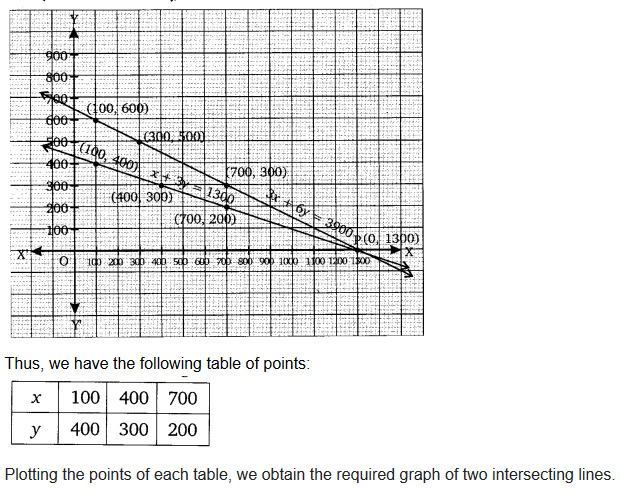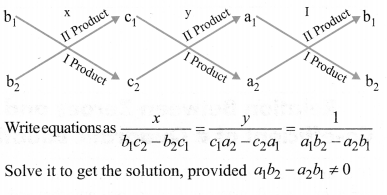This exercise introduces the concept of solving real-life problems using linear equations in two variables. Each problem can be translated into a pair of equations, helping us find the values of two unknowns. By accessing the solutions to this exercise, students can:

- Learn how to form equations from word problems
- Understand how to represent situations algebraically
- Visualize equations graphically using straight lines
- Identify whether a pair of equations has one solution, no solution, or infinitely many solutions
The solutions are step-by-step, easy to follow, and designed to build a strong foundation for solving linear equations confidently.
Pair of Linear Equations in Two Variables Ex 3.1 – Full Chapter Solutions
Question 1.
Aftab tells his daughter, “Seven years ago, I was seven times as old as you were then. Also, three years from now, I shall be three times as old as you will be”. Isn’t this interesting? Represent this situation algebraically and graphically.
Solution:
Let:
- Aftab’s age = x
- Daughter’s age = y
Equations:
- Seven years ago:
x − 7 = 7(y − 7)
⇒ x − 7y = -42 - Three years from now:
x + 3 = 3(y + 3)
⇒ x − 3y = 6
Solving:
From equations:
x − 7y = -42
x − 3y = 6
Subtract:
(−4y = −48) ⇒ y = 12
Substitute:
x − 3(12) = 6 ⇒ x = 42
Answer:
Aftab = 42 years, Daughter = 12 years
Graphical form:
Equations:
- x = 7y − 42
- x = 3y + 6
Lines intersect at (42, 12)
Question 2- Pair of Linear Equations in Two Variables Ex 3.1
The coach of a cricket team buys 3 bats and 6 balls for ₹ 3900. Later, she buys another bat and 3 more balls of the same kind for ₹1300. Represent this situation algebraically and geometrically.
Solution:
Let the cost of 1 bat be x and 1 ball be y.
From the given:
3x + 6y = 3900
x + 3y = 1300
Simplify the first equation:
Divide by 3:
x + 2y = 1300
So the two equations are:
x + 2y = 1300
x + 3y = 1300
To represent geometrically:
From x + 2y = 1300 ⇒ x = 1300 − 2y
From x + 3y = 1300 ⇒ x = 1300 − 3y
Table for x = 1300 − 2y:
y = 100 → x = 1100
y = 200 → x = 900
Table for x = 1300 − 3y:
y = 100 → x = 1000
y = 200 → x = 700
Plot both equations on a graph. The point where the lines intersect gives the solution for x and y.
Ex 3.1 – Pair of Linear Equations in Two Variables Ex 3.1
The cost of 2 kg of apples and 1 kg of grapes on a day was found to be ₹160. After a month, the cost of 4 kg of apples and 2 kg of grapes is ₹300. Represent the situation algebraically and geometrically.
Solution:
Let the cost of 1 kg of apples be x and 1 kg of grapes be y.
From the given:
2x + y = 160
4x + 2y = 300
Simplify the second equation:
Divide by 2:
2x + y = 150
Now the two equations are:
- 2x + y = 160
- 2x + y = 150
These are two parallel lines with no solution (inconsistent system).
Geometric representation:
From 2x + y = 160 ⇒ y = 160 − 2x
From 2x + y = 150 ⇒ y = 150 − 2x
Table for y = 160 − 2x:
x = 0 → y = 160
x = 50 → y = 60
Table for y = 150 − 2x:
x = 0 → y = 150
x = 50 → y = 50
Plot both lines on the graph. Since the lines are parallel and do not intersect, the system has no solution.
Pair of Linear Equations in Two Variables Ex 3.1 Mind Map
System of a Pair of Linear Equations in Two Variables
An equations of the form Ax + By + C = 0 is called a linear equation in two variables x and y where A, B, C are real numbers.
Two linear equations in the same two variables are called a pair of linear equations in two variables. Standard form of linear equations in two variables.
a1x + b1y + c1 = 0, a2x + b2y + c1 = 0
where a1, a2, b1, b2, c1, c2 are real numbers such that![]()
Representation of Linear Equation In Two Variables
Every linear equation in two variables graphically represents a line and each solution (x, y) of a linear equation in two variables, ax + by + c = 0, corresponds to a point on the line representing the equation, and vice versa.
Ploting Linear Equation in Two Variables on the Graph
There are infinitely many solutions of each linear equation. So, we choose at least any two values of one variable & get the value of other variable by substitution, i.e; Consider; Ax + By + C = 0 We can write the above linear equation as:![]()
Here, we can choose any values of x & can find corresponding values of y.
After getting the values of (x, y) we plot them on the graph thereby getting the line representing Ax + By + C = 0.
Method of Solution of a Pair of Linear Equations in Two Variables
Coordinate of the point (x, y) which satisfy the system of pair of linear equations in two variables is the required solution. This is the point where the two lines representing the two equations intersect each other.
There are two methods of finding solution of a pair of Linear equations in two variables.
(1) Graphical Method : This method is less convenient when point representing the solution has non-integral co-ordinates.
(2) Algebraic Method : This method is more convenient when point representing the solution has non-integral co-ordinates.
This method is further divided into three methods:
(i) Substitution Method,
(ii) Elimination Method and
(iii) Cross Multiplication Method.
Consistency and Nature of the Graphs – Pair of Linear Equations in Two Variables Ex 3.1
Consider the standard form of linear equations in two variables.
a1x + b1y + C1 = 0; a2x + b2y + c2 = 0
While solving the above system of equation following three cases arise.
(i) If a1a2≠b1b2; system is called consistent, having unique solution and pair of straight lines representing the above equations intersect at one point only
(ii) If a1a2=b1b2=c1c2 ; system is called dependent and have infinetly many solution. Pair of lines representing the equations coincide.
Algebraic Method of Solution – Pair of Linear Equations in Two Variables Ex 3.1
Consider the following system of equation
a1x + b1y + c1 =0; a2x + b2y + c1 =0
There are following three methods under Algebraic method to solve the above system.
(i) Substitution method – Pair of Linear Equations in Two Variables Ex 3.1
(a) Find the value of one variable, say y in terms of x or x in terms of y from one equation.
(b) Substitute this value in second equation to get equation in one variable and find solution.
(c) Now substitute the value/solution so obtained in step (b) in the equation got in step (a).
(ii) Elimination Method – Pair of Linear Equations in Two Variables Ex 3.1
(a) If coefficient of any one variable are not same in both the equation multiply both the equation with suitable non-zero constants to make coefficient of any one variable numerically equal.
(b) Add or subtract the equations so obtained to get equation in one variable and solve it.
(c) Now substitute the value of the variable got in the above step in either of the original equation to get value of the other variable.
(iii) Cross multiplication method – Pair of Linear Equations in Two Variables Ex 3.1
For the pair of Linear equations intwo variables:
a1x + b1y + C1 = 0
a2x + b2y + c2 = 0
Consider the following diagram.
Solve it to get the solution, provided a1b2 – a2b1 ≠ 0
Equations Reducible to a Pair of Linear Equations in Two Variables
Sometimes pair of equations are not linear (or not in standard form), then they are altered so that they reduce to a pair of linear equations in standard form.
For example;
Here we substitute 1x = p & \frac{1}{y} = q, the above equations reduces to:
a1p + b1q = c1 ; a2p – b2q = c2
Now we can use any method to solve them.
Class-wise Solutions
Class 12:
Class 12 Physics – NCERT Solutions
Class 12 Chemistry – NCERT Solutions
Class 11:
- Class 11 Physics – NCERT Solutions
- Class 11 Chemistry – NCERT Solutions
- Class 11 Biology – NCERT Solutions
- Class 11 Math – NCERT Solutions
Class 10:
Class 9:
Class 8:
Class 7:
Class 6:
Subject-wise Solutions
Physics:
Chemistry:
Biology:
Math:
- Class 11 Math – NCERT Solutions
- Class 10 Math – NCERT Solutions
- Class 9 Math – NCERT Solutions
- Class 8 Math – NCERT Solutions
Science:
- Class 10 Science – NCERT Solutions
- Class 9 Science – NCERT Solutions
- Class 8 Science – Oxford Solutions
- Class 7 Science – Oxford Solutions
- Class 6 Science – Oxford Solutions
NEET BIOLOGY
- Evolution
- Breathing and Exchange of Gases
- Anatomy of Flowering Plants
- Body Fluids and Circulation
- Human Health and Disease
- Microbes in Human Welfare
- Cell Cycle and Cell Division
- Biotechnology and Its Applications
- Biodiversity and Conservation
- Morphology of Flowering Plants
For the official Class 10 Mathematics Solutions, you can visit:
- NCERT Textbooks (for Class 10):
